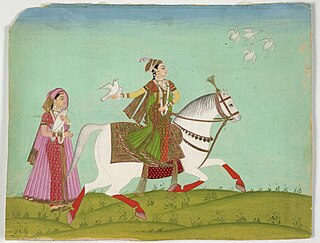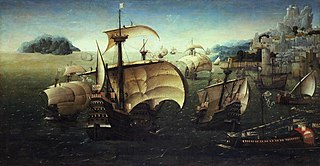The Deccan sultanates is a historiographical term referring to five late medieval to early modern Indian kingdoms on the Deccan Plateau between the Krishna River and the Vindhya Range that were created from the disintegration of the Bahmani Sultanate and ruled by Muslim dynasties: namely Ahmadnagar, Berar, Bidar, Bijapur, and Golconda. The five sultanates owed their existence to the declaration of independence of Ahmadnagar in 1490, followed by Bijapur and Berar in the same year. Golconda became independent in 1518, and Bidar in 1528.

The Sultanate of Bijapur was an early modern kingdom in the western Deccan and South India, ruled by the Adil Shahi or Adilshahi dynasty. Bijapur had been a taraf (province) of the Bahmani Sultanate prior to its independence in 1490 and before the former's political decline in the last quarter of the 15th century. It was a member of the Deccan Sultanates, the collective name of the five successor states of the Bahmani Sultanate. At its peak, the Sultanate of Bijapur was one of the most powerful states in South Asia, second to the Mughal Empire, which conquered it on 12 September 1686 under Aurangzeb.

Ibrahim Adil Shah II was Sultan of the Sultanate of Bijapur and a member of the Adil Shahi dynasty. Under his reign the dynasty had its greatest period as he extended its frontier as far south as Mysore. He was a skilful administrator, artist, poet and a generous patron of the arts. He reverted to the Sunni orthodoxy of Islam, but remained tolerant of other religions, including Christianity. However, during his reign high-ranking Shiite immigrants became unwelcome and in 1590, he ordered the confinement of criers who read the khutba in the Shia form. After his reign, increasing weakness permitted Mughal encroachment and the successful revolt of the Maratha king Shivaji, who killed the Bijapur general Afzal Khan and scattered his army. The dynasty left a tradition of cosmopolitan culture and artistic patronage whose architectural remains are to be seen in the capital city of Bijapur.

Yusuf Adil Shah (1450–1510), referred as Yusuf Adil Khan or Hidalcão by the Portuguese, was the founder of the Adil Shahi dynasty that ruled the Sultanate of Bijapur for nearly two centuries. As the founder of the Adil Shahi dynasty, Yusuf Adil Shah is credited with developing the town of Bijapur and elevating it to significant status.
Ismail Adil Shah was the Sultan of Bijapur who spent most of his time extending his territory. His short-lived reign helped the dynasty establish a stronghold in the Deccan.

Sultana Chand Bibi was an Indian ruler and warrior. She acted as the Regent of Bijapur Sultanate during the minority of Ibrahim Adil Shah II in 1580-1590, and regent of Ahmednagar Sultanate during the minority of her great nephew Bahadur Shah in 1595-1600. Chand Bibi is best known for defending Ahmednagar against the Mughal forces of Emperor Akbar in 1595.

The Battle of Raichur was fought between the Vijayanagara Empire and the Sultanate of Bijapur in 1520 in the town of Raichur, India. It resulted in a decisive victory for Vijayanagara forces, and the Bijapur ruler was defeated and pushed across the river Krishna.

Sikandar Adil Shah was the last Sultan of Bijapur, who reigned between 1672 and 1686. Placed on the throne at five years of age, his reign was marked by the collapse of the Bijapur Sultanate.
Rasul Khan was a general of Ismael Adil Shah, the Sultan of Bijapur, who commanded an army of Bijapur troops to recapture Goa from the Portuguese Empire in 1512. Khan's troops were repelled by forces commanded by Afonso de Albuquerque, culminating in the siege of the Benastarim fortress.

The Bijapur Fort is located in the Bijapur city in Bijapur District of the Indian state of Karnataka. Bijapur fort has a plethora of historical monuments of architectural importance built during the rule of Adil Shahi dynasty.

The Portuguese conquest of Goa occurred when the governor Afonso de Albuquerque captured the city in 1510 from the Adil Shahis. Old Goa became the capital of Portuguese India, which included territories such as Fort Manuel of Cochin, Bom Bahia, Damaon, and Chaul. It was not among the places Albuquerque was supposed to conquer. He did so after he was offered the support and guidance of Timoji and his troops.

The siege of Bijapur began in March 1685 and ended in September 1686 with a Mughal victory. The siege began when Aurangzeb dispatched his son, Muhammad Azam Shah, with a force of nearly 50,000 men to capture Bijapur Fort and defeat Sikandar Adil Shah, the then ruler of Bijapur, who refused to be a vassal of the Mughal Empire. The siege of Bijapur was among the longest military engagements of the Mughals, lasting more than 15 months until Aurangzeb personally arrived to organize a victory.
Events from the year 1510 in India.
Shahar Banu Begum was Empress consort of the Mughal Empire from 14 March 1707 to 8 June 1707 as the third wife of Emperor Muhammad Azam Shah. She is popularly known by the titles Padishah Bibi and Padshah Begum.

The War of the League of the Indies was a military conflict in which a pan-Asian alliance formed primarily by the Sultanate of Bijapur, the Sultanate of Ahmadnagar, the Kingdom of Calicut, and the Sultanate of Aceh, referred to by the Portuguese historian António Pinto Pereira as the "league of kings of India", "the confederated kings", or simply "the league", attempted to decisively overturn Portuguese presence in the Indian Ocean through a combined assault on some of the main possessions of the Portuguese State of India: Malacca, Chaul, Chale fort, and the capital of the maritime empire in Asia, Goa.
Khunza Humayun Begum also known as Kurja Sultana, Khanzada Humayun Sultana and Khunzah Humayun, was the regent of the Ahmadnagar Sultanate between 1565 and 1571, during the minority of her son sultan Murtaza Nizam Shah I.

D. Luís de Ataíde, 1st Marquess of Santarém and 3rd Count of Atouguia, was a Portuguese nobleman, military commander and statesman of the 16th century, who stood out for his military feats in the Portuguese State of India. He served as Viceroy of India for two non-subsequent terms.

Adil Shahi–Portuguese conflicts refers to the various armed engagements that took place in India between the Portuguese Empire and the Sultanate of Bijapur, ruled by the Adil Shahi dynasty, whose rulers were known to the Portuguese as Hidalcão.

The Deccani–Vijayanagar wars were a series of wars between 1495 to 1678 that pitted the rival powers of the Deccan Sultanates against the Vijayanagar Empire. Over the course of approximately 120 years, these two entities engaged in a series of wars and skirmishes that were marked by significant displays of military strength and strategic maneuvering.

The Siege of Daulatabad (1633) was a conflict between the Mughal Empire and the Ahmadnagar Sultanate, wherein the fort-city of Daulatabad was besieged by a Mughal force for several months and successfully captured. The Bijapur Sultanate also participated in the conflict against the Mughals, sending a large army to the aid of the fort's garrison. The conflict took place after several Mughal victories securing other minor forts in Ahmadnagar control, but was distinguished by the political significance of Daulatabad to the Ahmadnagar Sultanate. This event marked Mughal victory in the ongoing war between the Mughals and the Ahmadnagar Sultanate; it ended the Nizam Shahi dynasty and concluded the Sultanate, marking another step in the Mughal advance over the Deccan region. The victory did not fully quell resistance in the Western Deccan; a year later, Maratha commander Shahji Bhonsle attempted a bid for power using a puppet ruler of the Nizam Shahi house.













